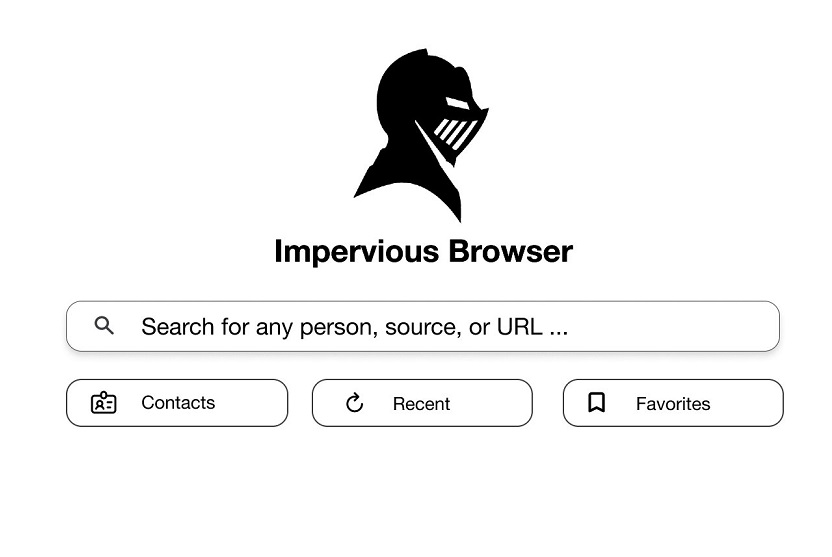The Impervious browser is upon us. The company will launch its most ambitious product at the Bitcoin 2022 conference in Miami, on April 7th. What is it, though? And, while you’re at it, what does Impervious do? Well, the company builds “tools and infrastructure for the P2P internet.” That is, the Internet without centralized intermediaries.
Related Reading | Attention Lightning Developers! The HRF And Strike Set 3 Bounties Of 1BTC Each
The company works over the Lightning Network, on bitcoin’s third layer. They already “released a bundle of APIs” which created “a programmatic layer for Bitcoin.” On that third layer, the Impervious browser lives. In the latest edition of their newsletter, the company described what we can expect from it. And Bitcoinist is here to summarize it because we know how busy you are.
The Impervious Browser: Your Portal to the P2P Internet
Zoom, without Zoom.
Google Docs, without Google.
Medium, without Medium.
WhatsApp, without WhatsApp.
Payments, without banks.
Identity, without the state.All without centralized intermediaries 😈🔥🚀#Bitcoin @lightning pic.twitter.com/Aujr6BQm5m
— Impervious.ai (@ImperviousAi) December 13, 2021
Impervious already promised a lot in a December tweet, namely:
Zoom, without Zoom.
Google Docs, without Google.
Medium, without Medium.
WhatsApp, without WhatsApp.
Payments, without banks.
Identity, without the state.
Can they deliver, though? Apparently, they can.
Is Bitcoin Layer 3 Even A Thing?
Another way of looking at what the company is doing, according to Jimmy Song, they “will essentially make every Lightning node a server as well as a client.” He then adds, “The dream of a decentralized internet seems to be building before our very eyes!” However, let’s take a step back.
What’s this “bitcoin layer 3” all about? The Impervious documentation puts it simply:
“At layer one, there exists the Bitcoin network – money, deep storage, global root trust.
At layer two, there exists the Lightning Network – cash, fluid payments, peer to peer trust.
At layer three, there exists the Impervious Network – applications, streaming micro payments, and node federation.”
What can it do, though? For that, we quote Coindesk:
“A “layer 3” network that can be used to set up decentralized virtual private networks (VPNs), messaging platforms, or even streaming videos or DJs or podcasts. “I can be in China, or I can be in Iran, and this allows us to speak freely without censorship,” explains Chase Perkins, Impervious’ founder and CEO.”
In other words, as the newsletter says, “the Impervious APIs enable any application or service to stream cryptographically secure, censorship and surveillance resistant data transmission channels.”
BTC price chart for 03/02/2022 on Oanda | Source: BTC/USD on TradingView.com
How Does The Impervious Browser Work?
The idea here is that the whole system is encrypted and doesn’t rely on third parties or central authorities. Great, but, how does it work? Well, “by interlacing Lightning, Decentralized Identifiers (DIDs), a DIDComm system, WebRTC, IPFS and more into a familiar application, the Impervious Browser is able to provide an entire suite of easy to use P2P capabilities.”
What Does The Product Offer?
- When Impervious says “WhatsApp, without WhatsApp,” they mean secure P2P messaging. The company promises “real-time P2P communication between browsers and DIDs” and “Secure P2P file transfer.”
- When the company says “Zoom, without Zoom,” they mean secure P2P audio and video calls. That is “audio, video, messaging, and real-time data transmission.” They also promise that the “conversation only lives until the end of the call” and “available usage of data channels (ex. file transfers and games)”
- Impervious also promises “an anonymous, publicly accessible, decentralized data store” using the InterPlanetary File System or IPFS.
- When the company says “Google Docs, without Google,” they mean real-time P2P collaborative workspaces. Users will be able to “share the document privately amongst authorized peers, without unauthorized users or third parties being aware of the files existence.”
- What does “Medium, without Medium” mean? Newsletters, subscriptions, and direct content monetization. The Impervious browser lives over the Lightning Network, so, payments are already part of the system. Users will be able to “create pay-to-play links, prompting peers to fulfill a key exchange or Lightning Invoice to view premium content.”
- The most exciting feature might be “Identity, without the State.” Using decentralized user identity (DID), users will be able to “generate decentralized identities via ION (a globally accessible, public, Decentralized Identifier network that runs on top of the Bitcoin blockchain) – directly from the Impervious Browser.”
Related Reading | Bitcoin Detractor David Heinemeier Hansson Says “I Was Wrong, We Need It”
There are few projects that sound as exciting as this one. However, the question remains: can Impervious deliver? We’ll have to wait for Bitcoin 2022 to find out.
Featured Image: Impervious Browser preview from this tweet | Charts by TradingView
